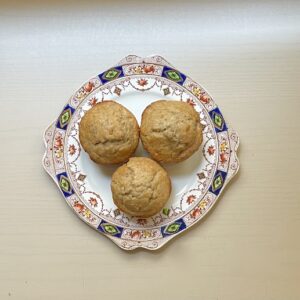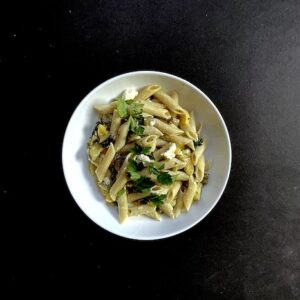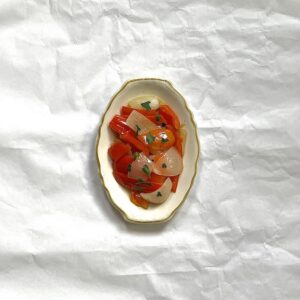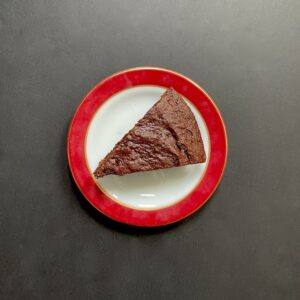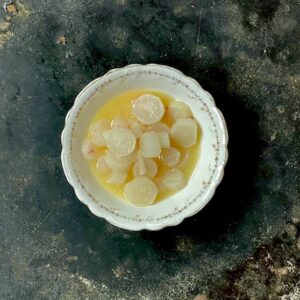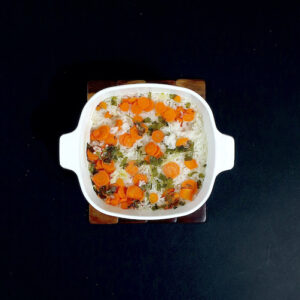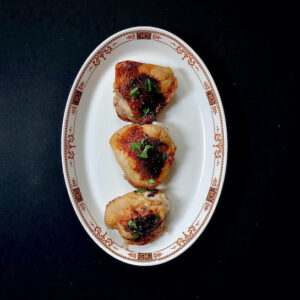Zucchini and tomato baked pasta is one of those recipes that reads long and complicated but is neither. It’s also vegetarian and easily made vegan, should the need arise. Still not sold? Zucchini and tomato baked pasta improves with keeping, meaning it may be prepared ahead of time.

The dish has three components: the pasta, the vegetables, and a tomato cream sauce. Don’t shriek. None are difficult or especially time consuming. Further, the vegetables and tomato cream sauce are prepared in the same pot, saving on washing up.

Into the kitchen.
First, the pasta:
I used pacheri pasta, because I had it in the house.
Think very large penne. Don’t cook the pasta beyond al dente, as it will be baking in the oven.

Before straining the pasta, reserve a cup of the pasta cooking water. You may need it to top up the liquid in baking dish.

Strain the pasta and add it back to the pot, off heat.
The vegetables:
I used two organic zucchini and one large tomato. I did not peel or seed either vegetable, but feel free to do so. Or, as mentioned above, substitute other vegetables.

My husband hates onion. Hopefully the you aren’t dealing with an onion hater.

The vegetables are gently sauteed in butter and olive oil for about 15 minutes. You want them softened and lightly browned. A shot glass of cheap red wine is optional.

Once the vegetables are done, add them to the strained pasta.

To make the sauce, combine dairy with a tablespoon of flour. I used half-and-half, but use whatever you wish. Once this is blended, you’ll make the sauce. Taste–this may need more tomato paste, salt, or pepper.

A note about the mozzarella: I tried making the pasta using ricotta. The result was okay. But that’s all it was. The mozzarella adds depth, flavor, and texture. Ricotta is a lovely cheese. It’s just not quite right here.

At this point the pasta and veg go into the baking pan and the sauce is added. If it looks a bit scant, add enough pasta water to come about 3/4 up the pan.

Sprinkle a handful of panko over, or not.
Set the pan on a baking sheet and slide the whole thing into the oven.
Bake for about 25 minutes, or until the pasta is bubbling.
Serve with salad, or by itself.

—
Zucchini and Tomato Baked Pasta
yield: serves 2-3
For the Pasta:
16 ounces/1 pound/454 grams Pacheri or Penne Pasta
For the vegetables:
olive oil-for the pan
butter-for the pan
1 medium yellow onion, peeled and chopped
1-3 garlic cloves, crushed, peeled, and minced
Approximately 14 ounces/400 grams Zucchini–about 2 medium, sliced into coins
1-2 medium-sized fresh tomatoes, chopped
salt and pepper
1 tablespoon/15 ml red wine (optional)
For the Tomato Cream Sauce:
Olive oil-for the pan
butter-for the pan
4 ounces/1/2 cup/120ml half-and-half, milk, cream, or 2% skim milk
1 tablespoon flour
2 teaspoons tomato paste
one 14-ounce/411-gram can low salt crushed tomatoes
One 8 ounce/227 gram ball Mozzarella Cheese, torn into pieces
1/2 teaspoon dried oregano
1/2 teaspoon onion powder
1/8 teaspoon-1/2 teaspoon hot red pepper flakes–to taste
salt and pepper, to taste
For the baking pan:
butter or olive oil
panko, for the top of the dish (optional)
Preheat the oven to 375F/190C. Butter or oil a baking dish approximately 8x11in/20×25 cm.
Make the pasta:
Place a strainer in the sink. Have a measuring cup ready as well.
Fill a large pot with salted water and bring it to a boil. Add the pasta and cook it to just al dente: it will be cooking further in the oven. Before straining the pasta, reserve one cup pasta cooking water.
Tip the strained pasta back into the pot. Set pot aside, off heat.
Cook the vegetables:
I did not peel or seed the zucchini or tomatoes, but feel free to do so. If tomato peel in a cooked dish annoys you, drop raw tomato in boiling water for 20 seconds or so; this will loosen the peel, easing its removal. Otherwise, it will come off in cooking and you can remove it from the pot. Or not.
Peel and chop the onion and garlic. Slice the zucchini into coins. Chop the tomatoes.
Pour the olive oil into a large saucepan. Add the butter. You want enough oil and butter to coat the bottom of the pan. Once the butter is melted, add the garlic and onion. Cook over gentle heat for five minutes or so, until vegetables become translucent. Do not allow to brown; if they are browning rapidly, turn heat down.
Once alliums are translucent, add zucchini, tomato, and wine, if using. Turn up the heat a bit. If the pan is dry, add a little more oil. If the pan is really dry, add some water.
Stir well. Let the vegetables cook down, 10-15 minutes, stirring frequently to avoid sticking. Salt and pepper lightly; the sauce will seasoned pretty highly.
Once the zucchini has browned and the tomato has cooked down considerably, tip the vegetables into the pasta pan.
Make the Tomato Cream Sauce:
Using the same pot you made the vegetables in, add more olive oil and butter to the pot.
Pour in the dairy. Slowly shake in the flour. Stir constantly with a wooden spoon. Given the size of the pot, the dairy/flour mixture will seem scant. Don’t worry.
Once the flour is integrated, or seems like it’s getting there, add the tomato paste. Gradually add the tomato sauce. If at any time the sauce gets grainy, grab a fork or whisk and have a go at it. Remember you are the boss. Do not let a pot of sauce intimidate you.
Now add the mozzarella, in pieces. It may take a few moments to melt, but it will. Meanwhile, add the seasonings.
Stir until the sauce is integrated. Now taste: it might need more salt or tomato paste; decide. Once it’s to your liking, turn the heat down to lowest setting.
Tip the pasta and vegetables into the baking pan, making sure everything is evenly distributed.
Give the sauce a final stir, then carefully pour it over the pasta and vegetables. Sauce should come about 3/4 of the way up the sides of the baking dish. If it doesn’t, add enough pasta water to compensate.
Scatter panko over the top of the pasta, or not, place pasta dish on a baking sheet, and slide it into the oven. Bake 25-30 minutes, or until bubbling hot.
Serve zucchini and tomato baked pasta hot, warm, or at room temperature. Leftovers are wonderful eaten cold on bread, which sounds weird but really is good.
Leftover zucchini and tomato baked pasta may be refrigerated in a lidded container up to four days. Freezing is possible but not recommended, as the vegetables will become soggy.
Zucchini and tomato baked pasta may be assembled up to four days ahead of time and refrigerated. Cook directly from the refrigerator; expect the dish to take a little longer to cook.
As noted in the post, the dish may be prepared using vegan milks and cheeses.
If you keep company with zucchini haters, feel free to use other vegetables in the dish. Eggplant, potatoes, artichoke bottoms and red peppers all work here. So do leafy greens like chard, mustard, and collards.















